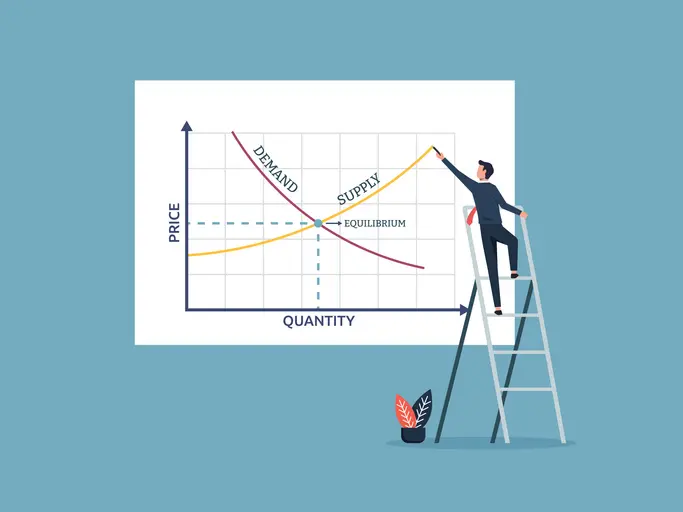E-commerce is an industry characterised by swiftness thus demand forecasting is the backbone of profitability, operational efficiency, and customer satisfaction. Accurate forecasting allows businesses to predict future sales and inventory needs, ensuring the right products are available at the right time—preventing costly stockouts or overstock situations. As e-commerce grows more complex, effective forecasting requires a multi-faceted approach, combining data-driven insights, sophisticated models, and cutting-edge technologies like artificial intelligence and machine learning.
In embracing these advanced techniques, businesses can anticipate trends, optimise inventory management, and deliver seamless customer experiences. In an environment shaped by consumer behaviour, demand forecasting is not just a tool—it’s a strategic advantage that drives success in e-commerce.
The Importance of Accurate Demand Forecasting
Accurate demand forecasting is the cornerstone of success in e-commerce. It enables inventory optimisation, ensuring businesses maintain the right stock levels to meet customer demand without overstocking or running out of popular items. This balance not only cuts storage costs but also reduces the risk of products becoming obsolete, especially for those with shorter life cycles.
Effective forecasting also enhances supplier relationships by allowing businesses to place timely, well-planned orders. This efficiency can lead to reduced lead times, better pricing, and stronger negotiation power with suppliers, ensuring smooth operations.
At its core, accurate forecasting boosts customer satisfaction. Efforts to prevent stockouts and ensure availability play a vital role in creating a seamless shopping experience that fosters brand loyalty and higher retention rates.
Moreover, demand forecasting plays a crucial role in cost reduction. Aligning inventory with actual demand helps businesses avoid overproduction, unnecessary storage, and markdowns on excess goods, increasing operational efficiency. Combined, these factors—efficient inventory management, cost control, and customer satisfaction—drive sales growth, positioning the company to respond swiftly to market trends and increase profitability.
Demand Planning is changing. Join many other businesses in implementing an integrated approach to this process.
Key Factors Influencing E-commerce Demand
External Factors
E-commerce demand is shaped by several external forces that businesses must consider to make accurate predictions. Seasonality and market trends are among the most prominent, with products often experiencing demand spikes during specific times, such as holidays or events like Black Friday. Anticipating these patterns allows businesses to adjust their strategies effectively.
Economic conditions also play a vital role, as consumer spending tends to increase during periods of economic growth and tighten during downturns. Understanding the broader economic landscape enables businesses to align their forecasts with changes in consumer purchasing power.
Furthermore, evolving consumer behaviour—driven by cultural trends, technological advancements, and social influences—can drastically impact demand. For example, shifts toward sustainability or viral social media trends can dramatically alter buying preferences in certain categories.
Internal Factors
Internally, businesses have control over factors that can directly influence demand. Marketing strategies and promotions are among the most powerful drivers, as well-executed campaigns can cause surges in demand, while a lack of visibility can reduce sales.
Product availability and new launches are equally crucial. Accurate demand forecasting ensures stock levels align with anticipated sales, preventing stockouts or unsold inventory. Additionally, shipping policies and return processes can sway purchasing decisions—free shipping or hassle-free returns often boost customer confidence and influence demand.
Indispensable to businesses is a strong understanding and astute analysis of both external and internal factors, which facilitates a journey towards sharper demand forecasting and swift responses to market dynamics.
Types of Demand Forecasting Models
Demand forecasting models are broadly categorised into qualitative and quantitative approaches, each serving distinct purposes. Qualitative models rely on expert judgement, market insights, and historical trends, making them invaluable for predicting demand for new product launches where little data exists. These models often use tools like surveys, market research, and expert opinions to shape their forecasts.
In contrast, quantitative models are data-driven, using statistical techniques such as time series analysis, regression models, and cutting-edge machine learning algorithms to forecast demand. These models excel in accuracy when applied to products with established sales patterns, leveraging historical data to make precise predictions.
Both approaches offer valuable insights, with qualitative models guiding early-stage products and quantitative models optimising forecasts for established ones.
For a more detailed overview of various demand forecasting models, visit this page on demand forecasting.
Black Friday is fast approaching. Navigate the peaks with a winning strategy.
Common Challenges in E-commerce Demand Forecasting
Despite its advantages, demand forecasting in e-commerce faces several challenges that complicate accurate predictions. Seasonal variability is a major hurdle, as fluctuations due to holidays, festivals, or weather changes can lead to overstocking or stockouts during peak times, making it difficult to strike the right balance.
The rise of multi-channel data adds further complexity. E-commerce businesses often sell through diverse platforms—websites, mobile apps, social media, and marketplaces like Amazon—each with unique sales patterns. Consolidating this data for a unified forecast is daunting, especially when customer preferences vary across platforms.
Additionally, the high cart abandonment rates typical in e-commerce create uncertainty around conversion rates, making it harder to predict actual sales. Returns and exchanges further muddy the waters, complicating efforts to maintain accurate demand estimates.
Launching new products poses its own challenge, as the lack of historical data forces businesses to rely on proxy data or expert judgement, often leading to inaccurate predictions.
Unpredictable global events, like economic crises or pandemics, can disrupt even the most precise forecasts, triggering rapid changes in consumer behaviour that demand swift strategic adjustments.
Lastly, multi-echelon distribution networks, with inventory spread across warehouses, distribution centres, and retail outlets, require careful coordination. Forecasting demand across these levels is crucial to avoid stock imbalances, adding yet another layer of complexity to the process.
Techniques and Tools for Improving Forecast Accuracy
Demand forecasting has evolved from traditional methods to cutting-edge, data-driven approaches. Time series analysis, which examines historical sales data to identify trends and seasonality, remains a foundational technique. However, in today’s data-rich world, machine learning and AI-driven forecasts take accuracy to new heights by analysing vast datasets and uncovering hidden patterns, offering greater precision in unpredictable markets.
Advanced techniques like ARIMA models and regression analysis capture complex relationships, such as how pricing or promotions impact demand. For smaller businesses, tools like Excel provide straightforward but effective forecasting options, especially for basic trend modelling.
For more sophisticated needs, e-commerce businesses can leverage advanced software that integrates AI, machine learning, and real-time updates. These platforms offer multi-channel integration, advanced analytics, and scenario planning, empowering businesses to respond dynamically to demand shifts. Whether using simple tools or advanced systems, refining forecast accuracy is key to staying competitive in today’s fast-paced market.
Data Sources for E-commerce Demand Forecasting
Accurate demand forecasting in e-commerce hinges on the richness and diversity of data sources. Historical sales data serves as the foundation, revealing patterns, seasonality, and growth trends that guide future predictions. By analysing past performance, businesses can better understand how demand fluctuates over time and under various conditions, creating a solid base for their forecasting models.
Complementing this, website analytics and user behaviour provide deeper insights into customer interests. Tracking product views, time spent on pages, and shopping cart activity allows businesses to anticipate demand based on consumer preferences and intent, offering a more nuanced view of potential sales.
Staying attuned to market and industry trends further refines forecasting accuracy. Observing sector shifts, emerging technologies, or competitor actions enables businesses to adjust their strategies in response to evolving consumer interests. These trends, combined with insights into competitor behaviour, help businesses stay agile and forward-thinking.
Finally, external data such as economic indicators and competitor data provides broader context. Factors like GDP growth, inflation, and new competitor launches can significantly influence purchasing power and market dynamics. An integration of these external factors segues to more comprehensive, accurate demand forecasts, positioning businesses to navigate a rapidly changing landscape with confidence.
Best Practices for Successful E-commerce Demand Forecasting
Mastering e-commerce demand forecasting hinges on several best practices designed to boost accuracy and minimise errors. First, businesses must prioritise high-quality data. Reliable, up-to-date data is the backbone of accurate forecasts, making it essential to invest in collecting, cleaning, and regularly updating data. Outdated or flawed data can lead to poor inventory management and missed sales opportunities.
Next, advanced analytical models should be leveraged, especially for larger e-commerce operations. Techniques like machine learning and AI-driven tools can analyse massive datasets, uncovering patterns that traditional methods may overlook. These sophisticated models provide sharper predictions, enabling smarter business decisions.
In the fast-paced world of e-commerce, continuous monitoring and adjustment of forecasts is critical. Consumer preferences, market trends, and economic shifts are always in flux, so static forecasts are insufficient. By regularly refining forecasts with real-time data, businesses stay agile and responsive, avoiding costly missteps.
Finally, aligning demand forecasting with marketing and sales strategies enhances overall accuracy. Marketing campaigns, promotions, and product launches directly influence demand, so working closely with marketing teams ensures forecasts reflect these activities. This collaboration allows businesses to optimise inventory levels and be fully prepared to meet demand during key campaigns.
Leaning into these best practices, businesses can sharpen their forecasting, optimise inventory, and stay ahead in a dynamic marketplace.
The Role of AI and Machine Learning in Demand Forecasting
AI and machine learning are revolutionising demand forecasting in e-commerce, elevating both accuracy and efficiency. These technologies process vast datasets, uncovering patterns that traditional models often miss. AI-driven tools analyse complex inputs, from multi-channel sales to external factors, generating predictions that consider seasonality, customer behaviour, and more.
A standout benefit of AI is its ability to enable dynamic pricing. Through analysing real-time data on demand, competition, and consumer preferences, AI adjusts prices automatically to maximise both sales and profit margins. This ensures that businesses stay competitive without compromising profitability.
AI also enhances the customer experience by personalising interactions. By predicting what products a customer is likely to purchase based on browsing and purchase history, AI tailors recommendations, emails, and ads to individual preferences, boosting conversion rates and customer loyalty.
Additionally, AI improves inventory and return management. AI optimises inventory planning, helping businesses avoid overstocking or understocking. It also streamlines reverse logistics, crucial for maintaining operational efficiency in e-commerce.
AI and machine learning are transforming demand forecasting into a powerful tool that drives smarter, data-driven decisions across every facet of e-commerce operations.
Benefits of Accurate Demand Forecasting for E-commerce Businesses
Accurate demand forecasting is a game-changer for e-commerce businesses, driving growth and operational excellence. One of its greatest benefits is optimised inventory management—ensuring products are available when needed without overstocking. This balance cuts storage costs and reduces the risk of unsold goods, allowing businesses to efficiently meet demand while avoiding financial strain from excess inventory.
Another significant advantage is enhanced customer satisfaction. Precise forecasting ensures better product availability, reducing stockouts. When customers can consistently find what they want, their shopping experience improves, boosting loyalty and increasing repeat purchases.
Cost reduction is also a key benefit. By aligning inventory and production with actual demand, businesses minimise waste and inefficiencies, lowering operational costs. These savings can then be reinvested into areas like marketing or product development, fuelling further growth.
Moreover, demand forecasting strengthens marketing strategies. With better predictions of future demand, businesses can align their promotions with customer needs, ensuring campaigns are focused on the right products at the right time. This synchronisation enhances the impact of marketing efforts and drives higher sales.
In summary, accurate demand forecasting is essential for e-commerce success. It leads to optimised inventory, delighted customers, cost savings, and smarter marketing—ultimately helping businesses achieve long-term growth and sustainability.
Put your data to good use–collaborate with Intuendi.






